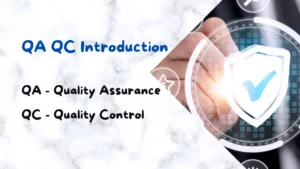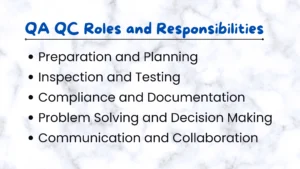QA QC Roles and Responsibilities Introduction:
In the dynamic world of oil and gas refineries and petrochemicals, shutdowns are critical moments. These planned maintenance periods, also known as shutdowns, are necessary to ensure the safety, efficiency, and reliability of operations. To keep machines and equipment’s working smoothly, quality assurance (QA) and quality control (QC) stand out as really important. QA-QC Engineers and inspectors play a big role in making sure things are done right during shutdown and plant maintenance. Let us find out the essential responsibilities they assume during refinery shutdown.

What is QA QC?
QA – Quality Assurance
QC – Quality Control
The word quality has many meanings, but basically, it refers to the set of inherent properties of an object that allows satisfying stated or implied needs. According to Joseph Juran (Joseph Moses Juran was a Romanian-born American engineer, management consultant and author. Quality means “fitness (suitability) for use”.
Understanding QA/QC Engineers and Inspectors:
QA/QC engineers and inspectors are like protectors of quality and safety in refineries. They carefully watch over everything during shutdowns to make sure it meets the rules and standards set by the industry.
Roles and Responsibilities

Preparation and Planning :- Prior to the shutdown, QA/QC professionals collaborate with maintenance teams to develop comprehensive inspection plans and procedures. They assess equipment conditions, identify potential risks, and establish protocols for quality control throughout the turnaround.
Inspection and Testing: During the shutdown, QA/QC engineers and inspectors conduct thorough examinations of equipment, pipelines, and structures. They utilize advanced inspection techniques such as non-destructive testing (NDT) to detect defects, corrosion, and structural weaknesses. Through meticulous testing and analysis, they ensure the integrity and reliability of critical assets.
Compliance and Documentation: QA/QC professionals carefully document all inspection findings, test results, and compliance measures throughout the shutdown process. They ensure adherence to industry regulations, safety standards, and environmental protocols. Comprehensive documentation serves as a vital reference for future maintenance and regulatory audits.
Problem Solving and Decision Making: In the fast-paced environment of refinery turnarounds, unexpected challenges are inevitable. QA/QC engineers and inspectors play a crucial role in troubleshooting issues, making informed decisions, and implementing corrective actions to minimize downtime and mitigate risks.
Communication and Collaboration: Effective communication is paramount during refinery shutdowns. QA/QC professionals liaise with cross-functional teams including maintenance crews, operations personnel, and management stakeholders. Clear communication channels facilitate timely decision-making and ensure alignment with project objectives.
Conclusion: During oil and gas refinery shutdowns, QA/QC engineers and inspectors are like the glue that holds everything together. They make sure that everything is safe, meets standards, and follows the rules. Their hard work ensures that maintenance goes smoothly and that refineries can keep running well for a long time. Let’s give a big shoutout to these QA/QC pros for keeping our refinery and petrochemical safe!
QA/QC work responsibility in shutdown for exchanger (Example)
1. Verify blinding of equipment as per blind list and marked P&ID
2. Erection of scaffolding to access all nozzles or CML (Condition Monitoring Locations) for NDT Purpose
3. Removal of insulation for CML, NDT and Inspection purpose
4. Preliminary or Pre cleaning inspection after opening of equipment (By Client and Process)
5. Post Cleaning Inspection (By Client and Process)
6. Marking for weld joint cleaning (wire brush or buffing) as per reliability for VI or PT
7. Borescope, ECT, RFET, IRIS of tubes as recommendation
8. Repair If any
9. Clearance for bundle installation, Witness for Hydro test (Shell side), Tube Plugging if required, Box up clearance for tube side hydro test ( verify gasket before box up, Pressure gauge, PSV, Check calibration certificate)
10. Final box up clearance and sign certificate 11. Gasket verification on location before De-blinding, de-blinding as per blind list, Verify flange torqueing
Download Free PDF for QA QC roles and responsibilities
Download PDF for Mechanical supervisor and foreman roles and responsibilities
Download PDF for Column or Tower maintenance procedure
Piping Question Answer Series Part – 02
Download Free PDF Part-01 Click Here
Read Also
Download Free Piping PDF for Interview Preparation
What is SMAW Welding What is gasket and their types What is a valve and its types?
